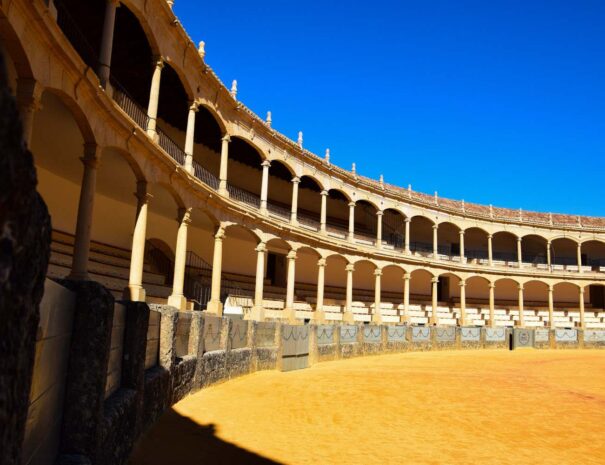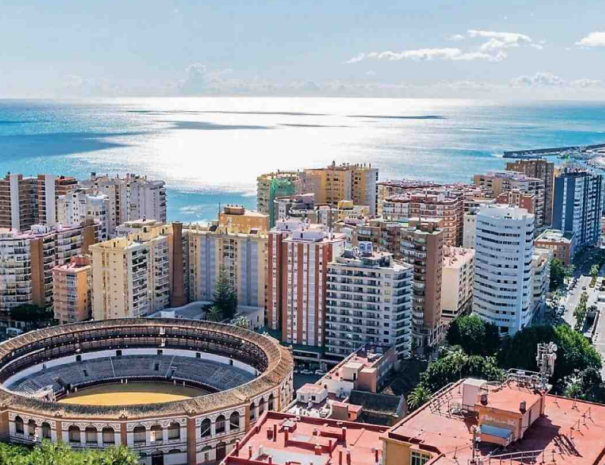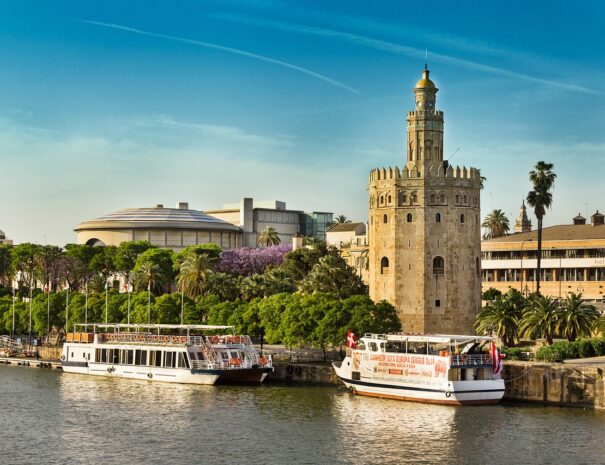
RONDA
The small town of Ronda is located in Málaga and has 35,000 inhabitants is the 3rd most visited place in Andalusia, and with good reason. Discover in this Ronda city guide the most interesting attractions in the city and the ways to make the most out of your visit to Ronda.
Ronda is straight out of a storybook. Ronda is perched high on a cliff and is divided in two by a canyon that runs through the town. The two halves are held together by an 18th century bridge.
Right at the edge of the sheer cliff that protected the town in less civilized times, you will also find one of the oldest and most storied bullfighting rings in all of Spain. This little corner of Andalusia is a truly magical place.
Our 3 top: hotels in Ronda
Catalonia Reina Victoria – 4 stars
Eurostars Azahar – Comfortable and attractive 4 star hotel in the historic city center of Córdoba
Parador de Ronda
Top Reasons To Visit Ronda
Breathtaking Scenery and the “Tajo”
Ronda is famous for its stunning natural beauty and dramatic landscapes. Located on a plateau in the mountains of the Sierra in the area of Pueblos Blancos, the city is built at the top of a high cliff and its famous bridge is built on a deep river gorge (called El Tajo). Cliffs, the river and its white houses create a true Andalusian picture!
Rich History and heritage
Ronda´s history dates back to Roman times (the Acinipo ruins located nearby are a great testimony of this past). As a visitor you will be able to explore historical sites like the Arab Baths, the ancient city walls, and the Mondragon Palace.
Gastronony
Ronda is renowned for its gastronomy and many charming restaurants, bars, and cafes scattered throughout the city are famous for their warm atmosphere. .Ronda and the Sierra nearby holds an important wine region “Sierras de Ronda” with very interesting projects and excellent wines.
Outdoor Activities and nearby villages
For outdoor enthusiasts is a greast place to enjoyhiking, rock climbing, and horseback riding. Ronda is an excellent base for exploring the Andalusian countryside and visiting nearby white villages such as Grazalema or Setenil de las Bodegas.
Most popular attractions in Ronda
Ronda and bulfighting
Ronda is home to one of the oldest bullfighting rings in Spain. Built in 1785, the Plaza de Toros de la Real Maestranza de Caballería de Ronda is the birthplace of modern bullfighting. The legendary bull fighter Francisco Romero introduced the use of the Red cape or Muleta to bait the bull and also was the first to face the bull on foot instead of on horseback, which was customary back then. Today the ring can be visited and includes a great museum that chronicles the history of Bullfighting in Ronda.
Such is the alure of Ronda that it is Andalusia’s 3rd most visited city and it sparked the fascination of the likes of Ernest Hemmingway and Orson Wells who fell in love with the towns culture and its relationship with bull fighting.
Cayetano Ordoñez, one of Ronda’s mythical bull fighters was the inspiration for the character Pedro Romero in Hemmingway’s novel Fiesta or the sun also rises. Hemingway also wrote A dangerous summer inspired by the fierce rivalry between Cayetano’s son, Antonio and matador Luis Miguel Dominguín during the 1959-60 season.
Orson Wells felt great affection for Spain and Andalucía in particular. He filmed what he claimed was his favourite film in Spain, Chimes at Midnight and his un-released film Don Quijote is still considered one of the great unfinished films of all times. Wells also developed a strong friendship with the Ordoñez family and the film makers ashes, per his request, are buried in the back yard of the Ordoñez estate.
Ronda is a town brimming with tradition, culture and folklore, a magical little corner of southern Spain that is well worth a visit.
More great Cities in south Spain

Malaga City Guide
Check out our Malaga City Guide to find all the information you will need to plan the perfect visit to this amazing city in Southern Spain … Read More

Jerez De La Frontera City Guide
Check out our Jerez De La Frontera City Guide to get all the information you need to plan the perfect visit to this gorgeous city in Southern Spain. … Read More

Seville City Guide
“Sevilla tiene un color especial” claims a famous Spanish song… The soul of this city may emerge from the passion of Flamenco in the taverns of Triana neighborhood, or from the greedy conquistadores that populated it, or you may have to blame Easter for it. No matter where the truth is that few cities in the world can pride themselves on being a perfect mix of beauty and charisma. Today you will learn about the history of Seville at the Alcazar, enjoy one of its most relaxing areas in Maria Luisa and, discover the passion of Flamenco in one of the flamenco shows in Seville. … Read More

Cordoba City Guide
Enjoy Cordoba, one of the most populated cities of the world in the Middle ages, in a 1 or 2 day city-break. Cordoba can be accessed by high speed train very easily from Madrid and this secure connection makes it easy to enjoy a break in Cordoba
Depending on your travel schedule you may decide to dedicate 1 or 2 days to Cordoba. One day is enough to enjoy the most important highlights and get a good feeling of the city. With 2 days you will be able to enjoy more attractions and even an excursion to MEdina Zahara. We have built this city-break in Cordoba including our recommendations for hotels, … Read More
is proudly powered by WordPress

